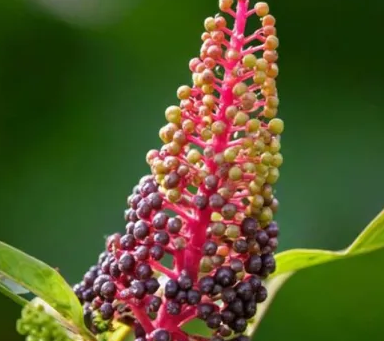Pokeweed (Phytolacca americana) is a striking perennial plant native to North America, notorious for its invasive nature and potent toxicity. While its vibrant purple stems and clusters of dark berries may seem ornamental, this plant is a serious concern for gardeners. Learn why pokeweed doesn’t belong in your garden, how to spot it, and effective ways to remove and prevent its spread.
Identifying Pokeweed: A Visual Guide 🕵️♂️
Pokeweed’s appearance is distinct, making it relatively easy to recognize:
- Height: It grows 4 to 10 feet tall.
- Stems: Smooth, stout, and purplish in color.
- Leaves: Large (up to 12 inches long), lance-shaped or oval, and deep green.
- Flowers and Berries: Small, greenish-white flowers bloom in clusters, maturing into glossy dark purple berries.
Birds, attracted to the berries, often disperse pokeweed seeds over wide areas, contributing to rapid infestations.
Toxicity of Pokeweed: Why It’s Dangerous ☣️
Every part of the pokeweed plant—roots, stems, leaves, and berries—contains toxic compounds like saponins, alkaloids, and lectins.
- Most Toxic Part: The roots are especially dangerous.
- Symptoms of Poisoning: Nausea, vomiting, diarrhea, abdominal pain, and in severe cases, respiratory failure or convulsions.
Warning: Keep children and pets away from pokeweed to prevent accidental ingestion.
Common Mistakes Leading to Infestations ❌
Pokeweed thrives due to missteps such as:
- Overlooking Young Plants: Small plants can go unnoticed, allowing them to mature and spread seeds.
- Improper Removal: Leaving root fragments in the soil enables regrowth.
- Composting Pokeweed: Seeds can survive the composting process, creating new infestations.
How to Manage Pokeweed Effectively 🌾
1. Control Early Growth
- Monitor your garden regularly to spot young plants.
- Remove seedlings before they mature and produce seeds.
2. Manual Removal
- Tools Needed: Shovel, gloves, and long sleeves for protection.
- Steps: Dig around the base to extract the entire root system.
- Dispose of all plant material in sealed bags—never compost it.
3. Use Herbicides for Large Infestations
- Select herbicides targeting broadleaf plants.
- Apply carefully to avoid harming nearby desirable plants.
Prevention Is Key 🛡️
1. Limit Seed Germination
- Apply mulch to prevent sunlight from reaching pokeweed seeds.
- Grow dense ground covers or competitive perennials to crowd out potential invaders.
2. Regular Inspection
- Check your garden frequently, especially after noticing increased bird activity.
3. Maintain Cleanliness
- Clear debris and fallen berries promptly to minimize seed spread.
Ecological Impact of Pokeweed 🌍
Pokeweed has a dual role in ecosystems:
- Positive: Provides food for birds and stabilizes soil in degraded areas.
- Negative: Outcompetes native plants, threatening local biodiversity.
While it has ecological value, managing its growth in your garden ensures a balanced environment without compromising native flora.
FAQs About Pokeweed 🤔
Q: Is pokeweed deadly?
A: While rarely fatal, it can cause severe illness if ingested. Handle with care.
Q: Can pokeweed be composted?
A: No, seeds can survive composting and lead to new infestations.
Q: How do I permanently remove pokeweed?
A: Persistent removal of root systems and regular monitoring are essential.
By staying vigilant and employing these strategies, you can prevent pokeweed from overrunning your garden. A little effort today ensures a safer, healthier garden tomorrow! 🌱



